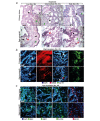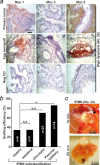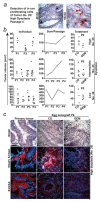Intraductal papillary mucinous neoplasm of the pancreas rapidly xenografts in chicken eggs and predicts aggressiveness
- PMID: 29143337
- PMCID: PMC5836935
- DOI: 10.1002/ijc.31160
Intraductal papillary mucinous neoplasm of the pancreas rapidly xenografts in chicken eggs and predicts aggressiveness
Abstract
Intraductal papillary mucinous neoplasm (IPMN) of the pancreas has a high risk of progressing to invasive pancreatic ductal adenocarcinoma (PDA), but experimental models for IPMN are largely missing. New experimental systems for the molecular characterization of IPMN and for personalized prognosis and treatment options for IPMN are urgently needed. We analyzed the potential use of fertilized chicken eggs for the culture of freshly resected IPMN tissue. We transplanted 49 freshly resected IPMN tissues into eggs and compared the growth characteristics to IPMN tissues transplanted into mice; this was followed by an analysis of histology, morphology, and marker expression. Of the IPMN tissues transplanted into eggs, 63% formed tumor xenografts within 4 days, while none of the 12 IPMN tissues transplanted into immunodeficient mice engrafted. In the eggs, the grafting efficiency of high-grade (n = 14) and intermediate-grade (n = 17) dysplasia was 77% and was significantly higher than the 39% grafting efficiency of low-grade dysplasia (n = 18). According to mucinous expression, 46 IPMN tissues were classified into gastric (n = 6), intestinal (n = 3), oncocytic (n = 23), and pancreatobiliary (n = 14) subtypes. The grafting efficiency was highest for the pancreatobiliary subtype (86%), followed by the oncocytic (70%), gastric (33%) and intestinal (33%) subtypes. The morphology and expression patterns of mucins, progression markers and pancreatic ductal markers were comparable between the primary IPMN tissues and their xenograft copies. The individual tumor environment was largely maintained during subtransplantation, as evaluated upon passage 6. This new IPMN model may facilitate experimental studies and treatment decisions for the optimal personalized management of IPMN.
Keywords: IPMN of the pancreas; chorioallantoic membrane; xenograft models.
© 2017 The Authors International Journal of Cancer published by John Wiley & Sons Ltd on behalf of UICC.
Figures





Similar articles
-
Clinicopathological features of intraductal papillary neoplasms of the bile duct: a comparison with intraductal papillary mucinous neoplasm of the pancreas with reference to subtypes.Virchows Arch. 2017 Jul;471(1):65-76. doi: 10.1007/s00428-017-2144-9. Epub 2017 May 26. Virchows Arch. 2017. PMID: 28550497
-
Intraductal papillary mucinous neoplasm.Hum Pathol. 2012 Jan;43(1):1-16. doi: 10.1016/j.humpath.2011.04.003. Epub 2011 Jul 20. Hum Pathol. 2012. PMID: 21777948
-
Intraductal papillary mucinous neoplasms of the pancreas with distinct pancreatic ductal adenocarcinomas are frequently of gastric subtype.Ann Surg. 2013 Jul;258(1):141-51. doi: 10.1097/SLA.0b013e31828cd008. Ann Surg. 2013. PMID: 23532108
-
[Intraductal papillary mucinous neoplasm of the pancreas (IPMN)--standards and new aspects].Zentralbl Chir. 2014 Jun;139(3):308-17. doi: 10.1055/s-0033-1350892. Epub 2013 Nov 15. Zentralbl Chir. 2014. PMID: 24241954 Review. German.
-
Molecular mechanism of intraductal papillary mucinous neoplasm and intraductal papillary mucinous neoplasm-derived pancreatic ductal adenocarcinoma.J Hepatobiliary Pancreat Sci. 2015 Jul;22(7):519-23. doi: 10.1002/jhbp.246. Epub 2015 Apr 21. J Hepatobiliary Pancreat Sci. 2015. PMID: 25900667 Review.
Cited by
-
Embryonated Chicken Tumor Xenografts Derived from Circulating Tumor Cells as a Relevant Model to Study Metastatic Dissemination: A Proof of Concept.Cancers (Basel). 2022 Aug 23;14(17):4085. doi: 10.3390/cancers14174085. Cancers (Basel). 2022. PMID: 36077622 Free PMC article.
-
Novel Broccoli Sulforaphane-Based Analogues Inhibit the Progression of Pancreatic Cancer without Side Effects.Biomolecules. 2020 May 15;10(5):769. doi: 10.3390/biom10050769. Biomolecules. 2020. PMID: 32429039 Free PMC article.
-
Enzyme-responsive vitamin D-based micelles for paclitaxel-controlled delivery and synergistic pancreatic cancer therapy.Mater Today Bio. 2025 Feb 4;31:101555. doi: 10.1016/j.mtbio.2025.101555. eCollection 2025 Apr. Mater Today Bio. 2025. PMID: 40026626 Free PMC article.
-
Improving germline transmission efficiency in chimeric chickens using a multi-stage injection approach.PLoS One. 2021 Jun 4;16(6):e0247471. doi: 10.1371/journal.pone.0247471. eCollection 2021. PLoS One. 2021. PMID: 34086696 Free PMC article.
-
Sulforaphane Inhibits the Expression of Long Noncoding RNA H19 and Its Target APOBEC3G and Thereby Pancreatic Cancer Progression.Cancers (Basel). 2021 Feb 16;13(4):827. doi: 10.3390/cancers13040827. Cancers (Basel). 2021. PMID: 33669381 Free PMC article.
References
-
- Ohashi KMY, Maruyama M, Takekoshi T, et al. Four cases of mucous‐secreting pancreatic cancer. Prog Dig Endosc 1982;20:348–51.
-
- Simons JP, Ng SC, Shah SA, et al. Malignant intraductal papillary mucinous neoplasm: are we doing the right thing?. J Surg Res 2011;167:251–7. - PubMed
Publication types
MeSH terms
LinkOut - more resources
Full Text Sources
Other Literature Sources
Medical
Research Materials

